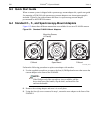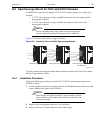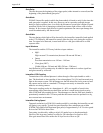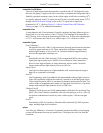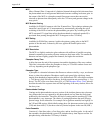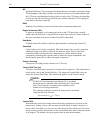
300 PI-MAX
®
4 System Manual Issue 4
EBI
Equivalent Background Illumination. EBI comes from thermally-generated electrons
that cannot be distinguished from those generated by light photons. EBI can be reduced
by cooling the intensifier (or environment) and is usually negligible in gated
applications.
Exposure Time
The period during which the camera allows incoming signal to integrate on the CCD
array. For signal to be detected and integrated on the CCD array, it must both fall in a
valid gate width and in a valid exposure time. In
Gate Mode, the exposure time is
determined by an internal pulse ensemble defined by the internal timing generator
gating setup.
External Sync
Readout synchronization mode where the CCD array is synchronized to an external
source, i.e., the array is scanned upon arrival of an external trigger pulse.
External Trigger Mode
Trigger mode where gate pulses are delayed from external input trigger pulses. Also a
camera readout synchronization mode where the camera is scanned continuously but
data storage does not begin until the arrival of an external trigger pulse.
Frame
The area of the CCD array that is readout after an exposure time ends. For a 1024x1024
array, a full frame would consist of the entire 1024x1024 pixel area. In the WinX/32
software, the number of frames to be acquired during a data acquisition is determined
by the Number of Images (or Number of Spectra) parameter on the
Experiment Setup
—> Main
tab. If the parameter value is greater than 1, multiple frames of data will be
acquired and stored in a single data file.
Frame Rate (fps)
The number of frames that can be readout per second. The effective frame rate can be
increased by defining a Region of Interest (ROI) that is smaller than the full-frame size.
This means that a selected portion of the image can be displayed and the remainder of
the accumulated charge discarded. The frame rate generally increases with reduction in
the size of the detected area. For example, a CCD with a sensor size of 1000 x 1000 and
an output rate of ten frames/second can produce 100 frames/second if the read-out
region is reduced to 100 x 100 pixels.
Full-Well Capacity
The number of electrons that can be stored in a pixel. The smaller the pixel, the fewer
electrons can be stored; therefore, either the exposure times need to be shorter or the
signal intensity must be lower. Note that binning relies on the full-well capacity of the
pixels in the serial shift register and of the output node. Typically, a serial shift register
pixel has a full-well capacity that is 2 times greater than that of an image pixel and the
output node has a full-well capacity that is about 1.5-2 times greater than that of a serial
register pixel.
FWHM
Full width half-maximum. Time period from the mid-point of the leading edge to the
mid-point of the trailing edge of the gate pulse. Used to describe pulse width.





